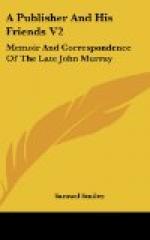Accordingly, increased efforts were made to have the Quarterly published with greater punctuality, though it was a considerable time before success in this respect was finally reached. Gifford pruned and pared down to the last moment, and often held back the publication until an erasure or a correction could be finally inserted.
No. 9, due in February 1811, was not published until March. From this time Southey became an almost constant contributor to the Review. He wrote with ease, grace, and rapidity, and there was scarcely a number without one, and sometimes two and even three articles from his pen. His prose style was charming—clear, masculine, and to the point. The public eagerly read his prose, while his poetry remained unnoticed on the shelves. The poet could not accept this view of his merits. Of the “Curse of Kehama” he wrote:
“I was perfectly aware that I was planting acorns while my contemporaries were setting Turkey beans. The oak will grow, and though I may never sit under its shade, my children will. Of the ’Lady of the Lake,’ 25,000 copies have been printed; of ‘Kehama’, 500; and if they sell in seven years I shall be surprised.”
Scott wrote a kindly notice of Southey’s poem. It was not his way to cut up his friend in a review. He pointed out the beauties of the poem, in order to invite purchasers and readers. Yet his private opinion to his friend George Ellis was this:
Mr. Scott to Mr. G. Ellis.
“I have run up an attempt on the ‘Curse of Kehama’ for the Quarterly: a strange thing it is—the ‘Curse,’ I mean—and the critique is not, as the blackguards say, worth a damn; but what I could I did, which was to throw as much weight as possible upon the beautiful passages, of which there are many, and to slur over its absurdities, of which there are not a few. It is infinite pity for Southey, with genius almost to exuberance, so much learning and real good feeling of poetry, that, with the true obstinacy of a foolish papa, he will be most attached to the defects of his poetical offspring. This said ‘Kehama’ affords cruel openings to the quizzers, and I suppose will get it roundly in the Edinburgh Review. I could have made a very different hand of it indeed, had the order of the day been pour dechirer.”
It was a good thing for Southey that he could always depend upon his contributions to the Quarterly for his daily maintenance, for he could not at all rely upon the income from his poetry.
The failure of the Edinburgh Annual Register, published by Ballantyne, led to a diminution of Southey’s income amounting to about L400 a year. He was thus led to write more and more for the Quarterly. His reputation, as well as his income, rose higher from his writings there than from any of his other works. In April 1812 he wrote to his friend Mr. Wynn:
Mr. Southey to Mr. Wynn.




